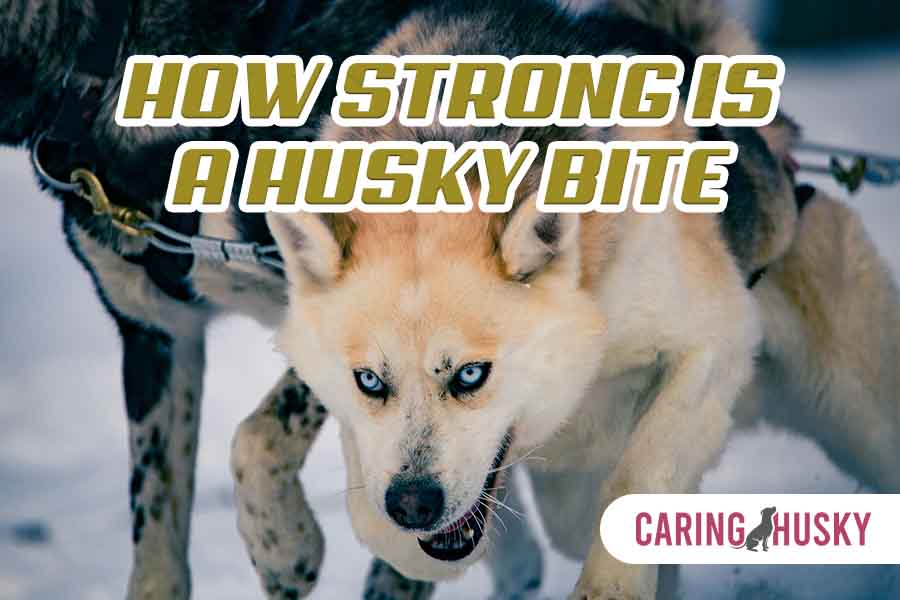The Siberian Husky, a breed renowned for its striking appearance and wolf-like features, has long captivated the interest of dog enthusiasts worldwide. Known for their endurance and strength, Huskies have historically been used as sled dogs in harsh Arctic conditions. One aspect that often intrigues people is the bite strength of this breed. How strong is a Husky’s bite, and what factors contribute to it? This article aims to explore the anatomical, genetic, and behavioral aspects that determine the bite force of a Husky. We will delve into scientific measurements, compare Huskies with other breeds, and debunk common myths about their temperament and aggression. Understanding the strength of a Husky’s bite not only satisfies curiosity but also provides insights into their nature and the importance of responsible ownership and training.
How Strong Is A Husky Bite?
A Siberian Husky’s bite force is estimated to be around 320 pounds per square inch (PSI). While formidable, this is moderate compared to some larger or more muscular dog breeds. Huskies’ bite strength reflects their genetics and physical build, suitable for their original roles as enduring sled dogs rather than for aggressive strength.
Structure Of The Jaw And Teeth In Siberian Huskies
Siberian Huskies possess a robust and well-proportioned jaw structure, which is a key component of their overall cranial anatomy. Their jaws are characterized by a strong mandible (lower jaw) and a well-formed maxilla (upper jaw), both of which are essential for effective biting and chewing. This structure allows for a wide opening and closing motion, providing Huskies with a powerful grip. The alignment of their jaws, known as a scissors bite, where the upper teeth closely overlap the lower teeth, aids in efficient food processing and is typical of the breed.
Huskies have 42 teeth in total, which include incisors, canines, premolars, and molars, each serving a specific function. The incisors are used for nibbling and grooming, while the canines, also known as fangs, are crucial for gripping and tearing. The premolars and molars play a significant role in grinding and crushing food. The Husky’s teeth are deeply rooted and strong, designed to endure the wear and tear of their original diet and environment, which included raw meat and bones.
The dental structure of Huskies is not only for feeding but also reflects adaptations for survival in harsh Arctic climates. Their strong teeth and powerful jaws were essential for chewing through frozen meat and bone, as well as for other survival tasks in the wild. This aspect of their anatomy showcases the breed’s evolution and adaptability to extreme conditions, making them proficient hunters and foragers in their native environments.
Types And Functions Of Teeth In Huskies
Huskies, like other dog breeds, have a diverse set of teeth, each type serving a specific function. Their dental arrangement allows them to efficiently process a variety of foods, reflecting their adaptability and survival capabilities. Understanding the types and functions of these teeth can provide deeper insights into their dietary habits and natural behavior.
- Incisors: Located at the front of the mouth, Huskies have six incisors on both the upper and lower jaws. These small, sharp teeth are primarily used for nibbling and grooming. They are instrumental in tasks like removing fleas or ticks from their fur and skin. In the wild, incisors help in scraping meat off bones or gnawing on small objects.
- Canines: These are the long, pointed teeth situated next to the incisors. Huskies have four canines, two on the top and two on the bottom. Canines are often referred to as fangs and are designed for tearing and holding onto things. They are critical in a Husky’s diet for gripping and tearing meat. In a non-domestic setting, canines are essential for a Husky’s hunting and self-defense mechanisms.
- Premolars: Behind the canines, there are eight premolars on each side of the mouth, both on the top and bottom. These teeth are used for shearing and cutting food. Premolars are especially important for Huskies in chewing hard materials like bones and frozen food. They act like scissors, slicing through tougher food items.
- Molars: At the back of the mouth, Huskies have molars – six on the top and six on the bottom. These are the largest teeth and are used for grinding and crushing food. The molars play a crucial role in breaking down food into smaller, digestible pieces. This is particularly important for Huskies, as their diet in the wild can include tough, fibrous materials.
How Bite Force Is Measured In Animals?
Bite force in animals is typically measured using a variety of scientific methods, each designed to accurately gauge the strength an animal can exert with its jaws. Understanding these methods provides insight into the comparative bite strengths of different species, including domestic dogs like Huskies.
- Direct Measurement With Bite Force Transducers: This is the most direct method. It involves using specialized devices known as bite force transducers, which are essentially pressure-sensing devices. These transducers are covered with a protective material and placed between the animal’s teeth. When the animal bites down, the device measures the pressure exerted. This method provides precise readings but can be challenging to use, especially with wild or untrained animals, due to the need for cooperation and the risk of damaging the equipment.
- Estimation Using Skull Mechanics And Computer Models: Scientists often use computer models and simulations to estimate bite force, especially for animals that are not feasible to test directly, like wild animals or extinct species. By studying the skull’s mechanical properties, including jaw structure, muscle attachment points, and lever mechanics, researchers can create models to estimate the force these jaws could produce. This method is particularly useful for studying dinosaurs and other extinct creatures.
- Calculation From Jaw Muscles And Lever Systems: Bite force can also be estimated by examining the jaw muscles’ size and strength, combined with the leverage provided by the jaw. The size of the jaw muscles, often estimated from the skull, can be used to infer the amount of force they can generate. This method, however, provides more of an estimate than an exact measurement, as it does not account for all the variables in a live bite.
- Electromyography (EMG) Studies: EMG involves recording the electrical activity produced by muscles. In studying bite force, EMG sensors are placed on the jaw muscles of an animal, and the electrical activity during biting is recorded. This method gives an indirect measure of bite force by showing how much the muscles are working, but it doesn’t translate directly to force measurements.
- Behavioral Observations And Feeding Habits Analysis: Sometimes, bite force is inferred from an animal’s natural behavior and feeding habits. For example, animals that crack hard shells or bones are likely to have strong bites. This approach is more speculative and less precise but can provide general insights, especially for animals where direct measurement is not possible.
How Age Affects A Husky’s Bite Strength?
Age significantly impacts a Husky’s bite strength, influencing it at different stages of their life. This change can be attributed to various factors including dental development, muscle maturation, and overall health.
- Puppyhood And Development: In their early months, Huskies, like all puppies, have weaker jaws. Their initial teeth, known as milk teeth or deciduous teeth, are not as strong or firmly rooted as adult teeth. During this stage, their bite is relatively weak and more for exploration and play than for exerting significant force. As they grow and their adult teeth emerge, usually around 6 months of age, their bite strength increases. This period is crucial for their jaw development and muscle growth.
- Adolescence And Maturity: As Huskies approach adolescence and eventually reach maturity (around 1 to 2 years of age), their bite strength reaches its peak. This increase is due to the full development of their jaw muscles and the complete eruption of their permanent teeth. Adult Huskies have a well-developed jaw structure and strong muscles, contributing to a powerful bite. This is the age when they exhibit their maximum bite force, which is a culmination of physical growth and development.
- Adult And Prime Years: During their prime years, Huskies maintain their maximum bite strength. Proper nutrition, exercise, and dental care are crucial during this period to sustain their jaw health and strength. This phase typically lasts until they are about 7-8 years old, depending on their overall health and genetics.
- Senior Years And Decline: As Huskies age into their senior years, usually beyond 8 years, there is a natural decline in their bite strength. This decrease can be attributed to several factors such as the weakening of jaw muscles, potential dental issues like tooth loss or decay, and a general decline in physical strength. Senior Huskies may have more difficulty in exerting the same level of bite force they once did in their prime. Regular veterinary care, focusing on dental health and managing any age-related conditions, is essential during this stage.
Safety And Prevention
1. Education On Dog Behavior And Body Language
- Understanding Huskies: Learn about the specific traits and behaviors of Huskies. They are known for being energetic, playful, and sometimes stubborn, which can influence their reactions.
- Recognizing Body Language: Being able to interpret a dog’s body language, such as growling, baring teeth, or a stiff posture, is crucial for preempting and avoiding potential bites.
2. Safe Interaction Guidelines
- Approaching Dogs: Teach both adults and children how to approach a Husky properly. Always ask the owner for permission, approach calmly, and avoid direct eye contact initially.
- Children And Dogs: Supervise interactions between children and Huskies. Teach children not to disturb dogs while they are eating or sleeping and not to engage in rough play.
3. Regular Exercise And Mental Stimulation
- Physical Activity: Huskies require regular exercise to expend their energy and maintain a calm demeanor.
- Mental Engagement: Provide mental stimulation through interactive toys, training, and games to keep them mentally satisfied and less prone to destructive behavior.
Final Word
In conclusion, understanding the strength of a Husky’s bite involves more than just numbers; it’s about appreciating the breed’s unique characteristics and needs. From their jaw structure to the influence of age and training, each aspect contributes to their overall behavior and capabilities. As majestic and friendly as Huskies are, responsible ownership, proper training, and informed interaction are key to ensuring a harmonious relationship with these beautiful animals. By respecting their nature and providing appropriate care, we can enjoy the enriching experience of sharing our lives with Huskies.
FAQ’s
Does A Husky’s Age Affect Its Bite Strength?
Yes, a Husky’s bite strength peaks in adulthood and gradually decreases with age, particularly in their senior years.
How Can I Prevent My Husky From Biting?
Regular training, socialization, and ensuring your Husky is mentally and physically stimulated can significantly reduce the likelihood of biting.
Are Huskies Naturally Aggressive?
Huskies are not naturally aggressive; they are generally friendly and sociable, but like all dogs, their behavior depends on upbringing and training.







Leave a Reply